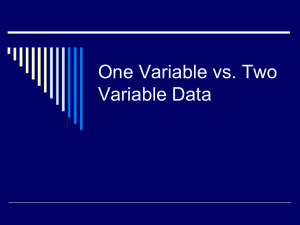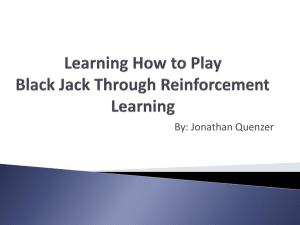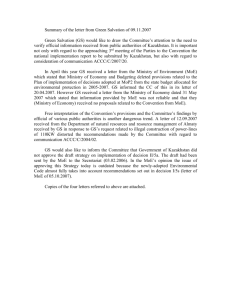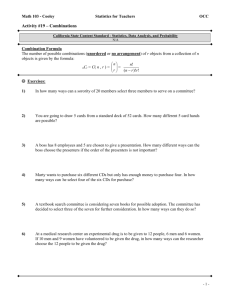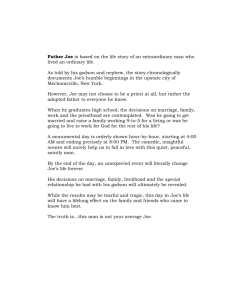AP Statistics – Ch 4 – More on Two-Variable Data
advertisement
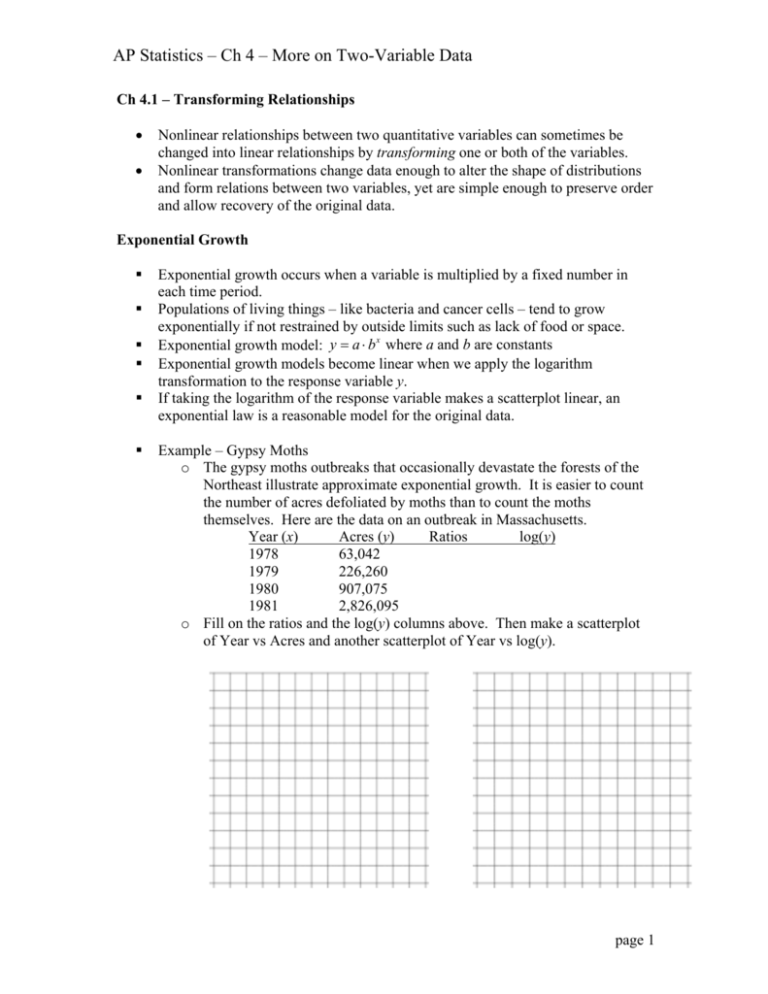
AP Statistics – Ch 4 – More on Two-Variable Data Ch 4.1 – Transforming Relationships • • Nonlinear relationships between two quantitative variables can sometimes be changed into linear relationships by transforming one or both of the variables. Nonlinear transformations change data enough to alter the shape of distributions and form relations between two variables, yet are simple enough to preserve order and allow recovery of the original data. Exponential Growth Exponential growth occurs when a variable is multiplied by a fixed number in each time period. Populations of living things – like bacteria and cancer cells – tend to grow exponentially if not restrained by outside limits such as lack of food or space. Exponential growth model: y = a ⋅ b x where a and b are constants Exponential growth models become linear when we apply the logarithm transformation to the response variable y. If taking the logarithm of the response variable makes a scatterplot linear, an exponential law is a reasonable model for the original data. Example – Gypsy Moths o The gypsy moths outbreaks that occasionally devastate the forests of the Northeast illustrate approximate exponential growth. It is easier to count the number of acres defoliated by moths than to count the moths themselves. Here are the data on an outbreak in Massachusetts. Acres (y) Ratios log(y) Year (x) 1978 63,042 1979 226,260 1980 907,075 1981 2,826,095 o Fill on the ratios and the log(y) columns above. Then make a scatterplot of Year vs Acres and another scatterplot of Year vs log(y). page 1 AP Statistics – Ch 4 – More on Two-Variable Data o Find the least squares line fitted to the transformed data. o Construct and interpret a residual plot for log yˆ on year. o Perform the inverse transformation to express yˆ as an exponential equation. o Use your model to predict the number of acres defoliated in 1982. page 2 AP Statistics – Ch 4 – More on Two-Variable Data Power Law Models Geometry tells us to expect power laws in some settings. Area goes up with the square of a dimension and volume goes up with the cube of a linear dimension. Power Law Model: y = a ⋅ x p Power law models become linear when we apply the logarithm transformation to both variables. If taking the logarithm of both variables makes a scatterplot linear, a power law is a reasonable model for the original data. Example – Light Intensity o The illumination from a light source varies inversely as the square of the distance from the light source. o When the distance from a light source is doubled, how does the illumination change? When the distance from a light source is tripled, how does the illumination change? o In physics class, a sensing device at various distances measured the intensity of a 100-watt light bulb, and the following data were collected. Distance (meters) 1.0 1.1 1.2 1.3 1.4 1.5 1.6 1.7 1.8 1.9 2.0 Intensity (candelas) 0.2965 0.2522 0.2055 0.1746 0.1534 0.1352 0.1145 0.1024 0.0923 0.0832 0.0734 log(x) log(y) o Fill in the log(x) and log(y) columns in the table above. page 3 AP Statistics – Ch 4 – More on Two-Variable Data o Make a scatterplot of the Distance vs Intensity and a scatterplot of log(x) vs log(y). o Find the least squares line fitted to the transformed data. o Perform the inverse transformation to express yˆ as a power equation. o Use your model to predict the light intensity 2.5 meters from the light source. page 4 AP Statistics – Ch 4 – More on Two-Variable Data Ch 4.2 – Cautions about Correlation and Regression Cautions Correlation and regression describe only linear relationships. Correlation r and the least-squares regression line are not resistant (i.e. they are easily influenced by outliers). Extrapolation is the use of a regression line for prediction far outside the domain of values used to obtain the line or curve. A lurking variable is a variable that is not among the explanatory or response variables in a study and yet may influence the interpretation of relationships among those variables. Correlations based on averages are usually too high when applied to individuals. That is because, for example, averaging over an entire month smoothes out dayto-day variation. Example—Hospital Stay o A study shows that there is a positive correlation between the size of a hospital (measured by its number of beds x) and the median number of days y that patients remain in the hospital. Does this mean that you can shorten a hospital stay by choosing a small hospital? Identify the explanatory and response variables in this study. Then explain what lurking variables account for the positive correlation. The Question of Causation Even a very strong association between two variables is not by itself good evidence that there is a cause-and-effect link between the variables. A variety of underlying links between variables can explain association. The dashed line represents an observed association between the variables x and y. The solid arrow shows the causal relationship. page 1 AP Statistics – Ch 4 – More on Two-Variable Data Causation: Changes in x cause changes in y. Common Response: The observed association between the variables x and y is explained by a lurking variable z. Confounding: Both the explanatory variable x and the lurking variable z may influence the response variable y. Example—Better Readers o A study of elementary school children, ages 6 to 11 finds a high positive correlation between shoe size x and score y on a test of reading comprehension. What explains this correlation? Example—Is Math the Key to Success in College? o Here is the opening of a newspaper account of a College Board study of 15,941 high school graduates: o Minority students who take high school algebra and geometry succeed in college almost the same rates as whites, a new study says. The link between high school math and college graduation is “almost magical,” says College Board President Donald Stewart, suggesting “math is the gatekeeper for success in college.” “These findings,” he says, “justify serious consideration of a national policy to ensure that all students take algebra and geometry.” o What lurking variables might explain the association between taking several math courses in high school and success in college? Explain why requiring algebra and geometry may have little effect on who succeeds in college. page 2 AP Statistics – Ch 4 – More on Two-Variable Data Ch 4.3 – Relations in Categorical Data Marginal Distributions To analyze categorical data, we use the counts or percents of individuals that fall into various categories. A two-way table describes two categorical variables. Values of the row variable label the rows that run across the tables, and the values of the column variable label the columns that run down the table. The row totals and column totals give the marginal distributions as percents of the table total. Discrepancies in the totals of a two-way table are due to roundoff error. To describe relationships among categorical variables, calculate appropriate percents from the counts given. Example – TV Viewing and Physical Fitness o Two-way table Fitness Level Not Physically Fit TV Viewing Time Physically Fit 0 hrs 35 137 1-2 hrs 101 629 3-4 hrs 28 222 5 or more hrs 4 44 Total Total o Calculate the row and column totals. o Display the marginal distribution of TV viewing time in terms of percents by dividing each row total by the table total and converting to a percent. page 1 AP Statistics – Ch 4 – More on Two-Variable Data Conditional Distributions Marginal distributions tell us nothing about the relationship between the variables. Conditional distributions are when you compare one variable to the different categories of the other variable. To find the conditional distribution of the row variable for one specific value of the column variable, look only at that one column in the table. Find each entry in the column as a percent of the column total. Example – TV Viewing and Physical Fitness (continued) o Find the conditional distribution of TV viewing times given that a person is physically fit. o Find the conditional distribution of TV viewing times given that a person is not physically fit. o Construct a segmented bar graph and describe the differences in TV viewing time between people that are physically fit and not physically fit. page 2 AP Statistics – Ch 4 – More on Two-Variable Data Simpson’s Paradox Simpson’s Paradox refers to the reversal of the direction of a comparison or an association when data from several groups are combined to form a single group. Simpson’s paradox is an example of the effect of lurking variables on an observed association. Example – Baseball Paradox o Most baseball hitters perform differently against right-handed and lefthanded pitching. Consider two players, Joe and Moe, both of whom bat right handed. The table below records their performance against righthanded and left-handed pitchers. Player Joe Moe Pitcher Right Left Right Left Hits 40 80 120 10 At Bat 100 400 400 100 o Make a two-way table of player (Joe or Moe) versus outcome (hit or no hit) by summing over both kinds of pitcher. All Pitchers Player Joe Moe Total Hit Outcome No Hit Total o Find the overall batting average (hits divided by total times at bat) for each player. Who has the higher batting average? page 3 AP Statistics – Ch 4 – More on Two-Variable Data o Make a separate two-way table of player versus outcome for each kind of pitcher. From these tables, find the batting averages of Joe and Moe against right-handed pitching. Who does better? Do the same for lefthanded pitching. Who does better? Right-handed Pitchers Player Joe Moe Total Hit Outcome No Hit Total Outcome No Hit Total Left-handed Pitchers Player Joe Moe Total Hit o The manager doesn’t believe that one player can hit better against both left-handers and right-handers yet have a lower overall batting average. Explain in simple language why this happens to Joe and Moe. page 4
